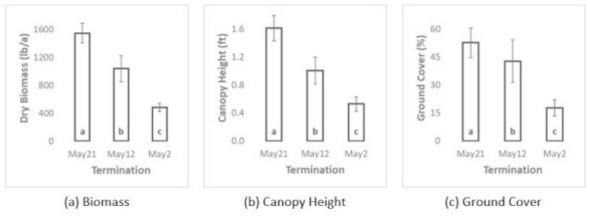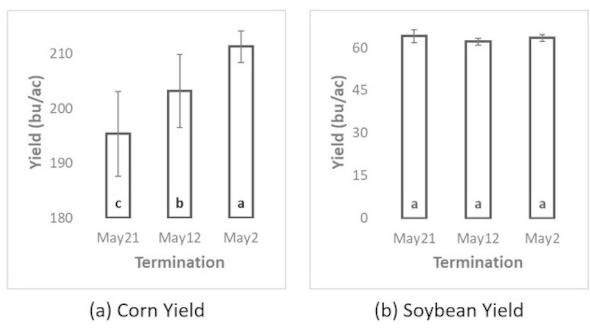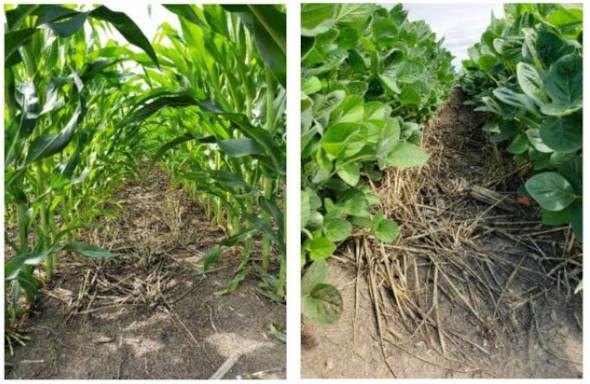By Lizabeth Stahl
When using an over-wintering cover crop, the traditional recommendation has been to terminate it two weeks prior to planting the primary crop, usually corn or soybean, to prevent a reduction in productivity. Such a strategy in Minnesota doesn’t allow for much cover crop biomass though, especially when planting early to optimize yield. Planting corn or soybean into a living cover crop, or planting green, might be a strategy for late cover crop termination, and therefore higher biomass and potential benefits. In fact, planting green has been gaining much interest, although little research has been done on this practice to date in the state.
Potential Pros and Cons
In general, the more biomass produced by a cover crop, the more likely you are to see benefits. In regions like Minnesota, where the cover crop growing season is very short, delaying termination until planting allows more time for the cover crop to accumulate biomass. Potential benefits of planting green include:
- Enhanced erosion protection
- Weed suppression
- Reduction in soil nitrate losses
- Increased plant and insect diversity
- Building of soil organic matter and structure
- Greater moisture retention into the season
On the flip side, there are potential disadvantages to planting green, including:
- Reduction in cash crop yield
- Water stress on the cash crop, especially in a drought year
- Challenging planting conditions
- Cooler soil temperatures that slow crop growth
- Reduction in nitrogen availability for the cash crop
- Reduced efficacy of a preemergence herbicide due to high residue levels on the soil surface
- Potential “green bridge” for insect and disease pests to the cash crop
Many factors influence the potential impacts of planting green on corn and soybean including the timeliness and effectiveness of termination, early-season growing conditions, pest and weed pressure, and nutrient status.
Pilot Study at Lamberton
To help address questions around cover crop termination when planting corn and soybean, a field study was initiated at the Southwest Research and Outreach Center near Lamberton. Cereal rye was drilled on September 6, 2019, at a rate of 60 pounds/acre using a Penn State Interseeder. The following spring, glyphosate (Cornerstone Plus) was used to terminate the cover crop at three different timings: 10-days prior to planting (May 2), at planting (May 12), and 9-days after planting (May 21) corn and soybean. Cover crop biomass, canopy height and ground cover were measured prior to termination and corn and soybean grain yield and moisture were obtained at harvest.
Results to date
Delaying termination significantly affected cover crop biomass, height, and ground cover (Fig. 1). Figure 2 illustrates the visual differences observed among treatments on May 21, the last termination date. Cover crop biomass increased as termination was delayed, with the May 21 termination resulting in the most biomass (1548 lb/acre) followed by the May 12 (1039 (lb/acre) and May 2 (483 lb/acre) termination times. Although this increase was significant, to put this into perspective if a goal of planting green was to help with weed control, research conducted in the region indicates that more than 4500 lb/acre of biomass would be needed to suppress weeds by 75% (Nichols et al., 2020). While these results suggest terminating cereal rye even 9 days after planting may not dramatically impact weed control, other benefits like reduced soil erosion and enhanced soil health might be highly associated with its use.

Figure 1. Effect of termination timing on biomass (a), canopy height (b) and percent ground cover (c) of cereal rye seeded September 6, 2019. Within each graph, means with the same letter are not significantly different (alpha = 0.05). The study was conducted at the University of Minnesota’s Southwest Research and Outreach Center near Lamberton, MN.

Figure 2. Cereal rye cover crop on 5/21/20, corresponding to the last termination date. Cereal rye biomass, height, and ground cover increased as termination was delayed. (Photos by Liz Stahl)
Delaying cover crop termination significantly affected corn yield, but not soybean yield (Fig. 3). Corn yield was highest at 211 bu/acre when the cover crop was terminated 10 days prior to planting compared to 203 bu/acre when the cover crop was terminated at planting (203 bu/acre). Corn yield was reduced further to 195 bu/acres when the cover crop was terminated 9 days after planting. In contrast, soybean yielded around 63 bu/acre across all termination dates. These results are similar to research conducted in Pennsylvania where corn was found to be more vulnerable to yield loss than soybean when planting green (Reed, et al., 2019).
Cereal rye residue could still be observed in both corn and soybean later in the cropping season (Fig. 4)

Figure 3. Effect termination timing of a cereal rye cover crop seeded September 6, 2019 on grain yield of (a) corn and (b) soybean planted May 12, 2020. Within a crop, yields with the same letter are not significantly different (alpha = 0.05). The study was conducted at the University of Minnesota’s Southwest Research and Outreach Center near Lamberton, MN.

Figure 4. Growth and development of corn @ V12 (left) and soybean @ R3 (right) on 7/11/2020. Crops were planted on May 12. Note the amount of residue remaining on the soil surface from the terminated cover crop. (Photos by Axel Garcia y Garcia)
Considerations and tradeoffs
- We found a higher risk of impacting crop yield when corn was planted green compared to soybean. Termination timing didn’t impact soybean yield in this trial, but it is important to note that results are from only one year at of research at one location and results could vary depending on soil moisture status, growing conditions, and other factors. Further research is needed to help fine-tune recommendations and to better define the benefits and risks of delaying cover crop termination.
- The following are some general recommendations when looking at planting green:
- If you are just starting out with cover crops, consider waiting to try planting green until you have some experience with cover crops. Instead, consider a cover crop that does not overwinter, or terminate the cover crop prior to planting.
- Keep an eye on the weather. In a dry spring, such as what we are experiencing so far in 2021, you may want to terminate earlier to reduce the risk of water stress due to low soil water availability to crop. Likewise, if you planted green and the forecast calls for rain, consider terminating the cover crop as soon as possible to prevent field conditions from keeping you out of the field until after the cover crop has competed with the crop.
- If planting green with corn, consider a Bt-hybrid that provides control of pests like true armyworm and black cutworm (see the Handy Bt-Trait Table). Be sure to scout for any pest issues.
Be sure to effectively terminate the cover crop. For example, glyphosate has provided the most effective and consistent control of cereal rye compared to glufosinate and paraquat.
Source : umn.edu